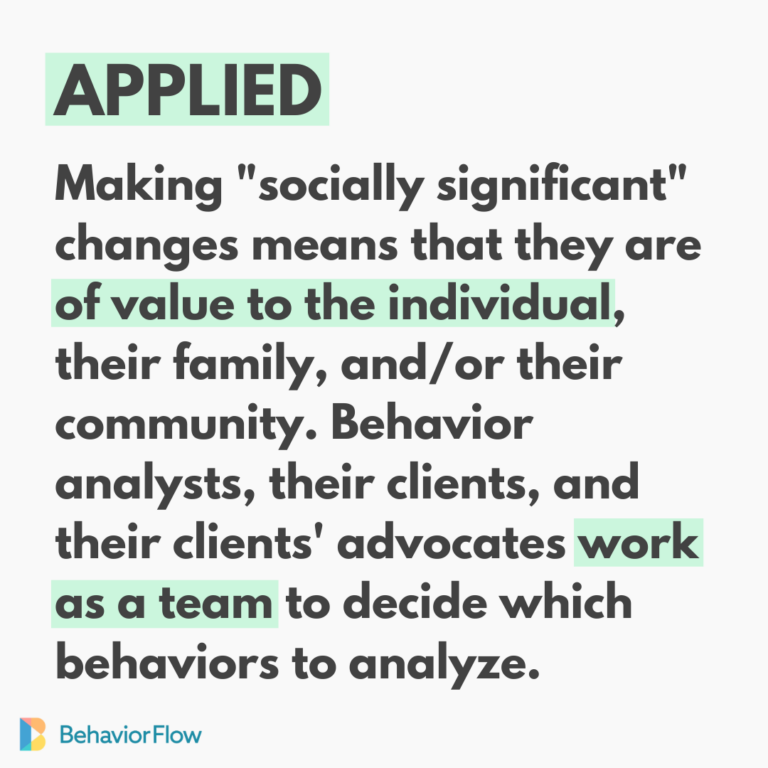What is aba?
BehaviorFlow is designed on the principles of Applied Behavior Analysis (ABA). Within the realm of autism education ABA is considered to be the gold standard, and is certified as an evidence-based best practice by both the US Surgeon General and the American Psychological Association.
ABA has found a firm foothold in the autism education world, but the potential application of its principles to improve human behavior are almost limitless. Here, we provide a beginner’s introduction to the science.
Written by Dan McFadden,
Founder of BehaviorFlow

Ok, first things first – let’s nail down a definition of ABAApplied Behavior AnalysisApplied Behavior Analysis is … . For more detail click on the blue link below.
Applied Behavior Analysis (ABA): a discipline which takes principles from the science of behavior analysis and applies them to humans in order to make “socially significant” changes.

Ok… good to know. But what does that really mean? And why should we care?
To answer those questions, we’re going to take a closer look at what it means to be Applied, Behavioral, and Analytic.
Let’s get started by exploring what it means for a discipline to be Applied.
Applied
To me, “Applied” holds the essence of the discipline.
Making “socially significant” changes means that they are of value to the individual, their family, and/or their community. Behavior analysts, their clients, and their clients’ advocates work as a team to decide which behaviors to analyze.
In other words, we practice ABA to help individuals gain practical and valuable skills that they need to achieve their goals in life.
ABA is at its finest when this sentiment remains at the forefront of care.

Behavior

Ahh, Behavior.
The delicious meat in the middle of the ABA sandwich.
It may feel silly to dig too deep here; behavior is behavior, right?
But behavior analysts look at behavior in a very specific way, and it is this mindset that informs how they do what they do.
Behavior analysts think about behavior as a three-term contingency, “ABC“, or “Antecedent”, “Behavior”, “Consequence”.
By manipulating “A” and “C” we can change the ways that future behavior occurs.
As an example, let’s say that you are the manager of a store who needs to have work behavior (B) done in your store. So, you hire a new employee. You both sign a contract (A), the employee comes into the store and works (B), and you pay them (C). In this situation, working behavior is likely to be maintained.
Let’s try manipulating the Antecedent (A) in the equation by removing the work contract. In the absence of a contract or other kind of work agreement, you would likely never find anyone who will just walk into your store and start doing work for you. In this circumstance, work behavior (B) would probably never even start. Even if you were willing to pay a paycheck (C), without the proper antecedent, you probably won’t come into contact with the work behavior (B) that you desire.
Now let’s examine what would happen if you alter the Consequence (C) in the equation, by withholding pay. You hire a new employee (A), they come in and work (B), but when payday comes, you flake out and withhold the paycheck. Odds are that this particular worker will never come work for you again. Work behavior (B) has likely been eliminated altogether.


These ABC contingencies are functioning on us and around us all the time, whether we recognize them or not.
This knowledge is a behaviorist’s superpower.
By constantly thinking about the contingencies around us and how we can manipulate A and C variables, we can create robust behavior change.
This is how ABA creates behavior change, and why it is such a powerful and flexible discipline.
Analysis
Time to get nerdy.
ABA is a science after all, and the “Analysis” part is where Behavior Analyst’s ‘nerdiness’ really shines.
When a behavior change procedure is designed, behavior analysts clearly define the behavior of interest, as well as the tools and methods that will be used, and the data that will be collected.
You can tell if an effective job was done defining the procedures of a behavior change program if another behavior analyst with sufficient ABA skill could read the program and perform it in exactly the same way as the original author of the program.

As the procedure is implemented, performance data is taken to ensure a clear functional relation between treatment and the behavior. Data is the lifeblood of ABA; it informs all decisions on behavior change procedures, and how they must adapt to better meet the needs of students over time.
Summary

I like to think of “Applied”, “Behavior”, and “Analysis” as the “Why”, “How”, and “What” of our practice.
“Applied” informs why we do what we do. Our science is intended to help individuals to reach their goals by facilitating behavior change which is of value to them.
“Behavior” informs how we do what we do. Employing the behavior analyst’s mindset (of the ABC, or 3-term contingency) helps to bring about behavior change.
“Analysis” informs what we do. Behavior analysts utilize the principles of behavior analysis and the tools of modern science to ensure student progress and a “cause-and-effect” functional relation of interventions and behaviors.
Applied Behavior Analysis is a dynamic and powerful discipline which has been applied to a wide range of humanity’s most difficult problems. While ABA continues to grow and evolve as a discipline (and keeping in mind that we will never know EVERYTHING that there is to know about behavior) , the practice of ABA is inherently optimistic. We, as humans, are not stuck with the behaviors that do not serve our needs. This proven and practical discipline gives us the tools to help shape the behaviors that make us who we are.
Yours in all things ABA,
Dan
Much of the information in this post was collected from the textbook “Applied Behavior Analysis” by Cooper, Heron, and Heward. It is a treasure trove of the best and most current information on ABA as a practice today. A new edition was released in 2019, and the book can be found here: http://tiny.cc/5b8kmz